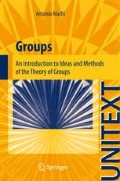Abstract
Definition 2.1. Let H and K be two subsets of a group G. The product of H by K is the set HK = {hk, h ∈ H, k ∈ K}.
Access this chapter
Tax calculation will be finalised at checkout
Purchases are for personal use only
Notes
- 1.
Obviously, a group structure may be given to the set of cosets of H even if H is not normal (a group structure can be given to any set). However, in this case, the group operation cannot be that of (2.2). In other words, (2.2) is a group operation if, and only if, H is a normal subgroup, and only in this case one speaks of a quotient group
- 2.
It does follow H ⊴ G if H is characteristic in K (cf. the observation before Theorem 2.25), or if K is a direct factor of G (Remark 2.3, 1).
- 3.
The element h -1k-1 hk is the commutator of h and k (see Section 2.9)..
- 4.
One may say that, in this case, uniqueness implies existence.
- 5.
Also known as the ‘fundamental theorem of homomorphisms‘.
- 6.
But there can be automorphisms fixing all conjugacy classes that are not inner (see Huppert, p. 22).
- 7.
Z is the initial of the German word Zentrum.
- 8.
It is the alternating group A 4 (see Section 2.8).
- 9.
This is true for all the groups S n, n = 2, 6 (Theorem 3.29).
- 10.
This result will be used in the proof of Theorem 5.54.
- 11.
Label x and –x two opposite faces of a cube, x = i,j, k. The 24 isometries of the cube give the 24 automorphisms of Q.
- 12.
The parity of a permutation can also be defined in terms of the inversions it presents (Corollary 3.19). For another proof that parity is well defined see ex. 115 of Chapter 3.
- 13.
A n has already been seen in its matrix representation (ex. 26 of Chapter 1).
- 14.
Some authors define the commutator of a and b as the element aba –1 b –1.
- 15.
Cf. Carmichael, p. 39, ex;. 30, or Kargapolov-Merzliakov, ex. 3.2.11.
- 16.
This holds for all An, n≥ . 5 (It.o N.: Math. Japonicae 2 (1951), p. 59-60).
- 17.
Cf. Kaplansky I.: An introduction to differential algebra. Hermann, Paris (1957), p. 59.
Author information
Authors and Affiliations
Rights and permissions
Copyright information
© 2012 Springer-Verlag Italia
About this chapter
Cite this chapter
Machì, A. (2012). Normal Subgroups, Conjugation and Isomorphism Theorems. In: Groups. UNITEXT(). Springer, Milano. https://doi.org/10.1007/978-88-470-2421-2_2
Download citation
DOI: https://doi.org/10.1007/978-88-470-2421-2_2
Publisher Name: Springer, Milano
Print ISBN: 978-88-470-2420-5
Online ISBN: 978-88-470-2421-2
eBook Packages: Mathematics and StatisticsMathematics and Statistics (R0)

